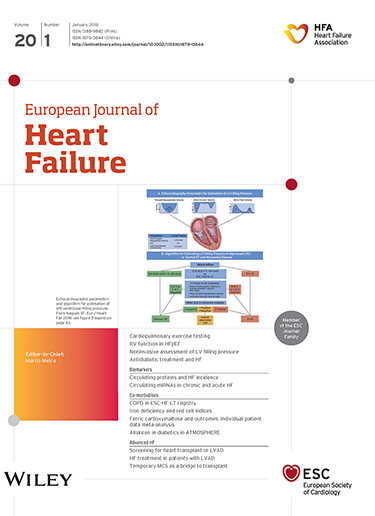Dynamic tricuspid regurgitation in heart failure with preserved ejection fraction.
IF 10.8
1区 医学
Q1 CARDIAC & CARDIOVASCULAR SYSTEMS
引用次数: 0
Abstract
AIMS The pathophysiology of tricuspid regurgitation (TR) during exercise in heart failure with preserved ejection fraction (HFpEF) is not well understood. METHODS AND RESULTS We investigated dynamic changes in TR severity during exercise in patients with HFpEF and associated relationships with haemodynamics, cardiopulmonary reserve, and prognosis using invasive haemodynamic exercise testing with simultaneous echocardiography and expired gas analysis. Among 169 patients with HFpEF (91 no TR, 44 mild TR, 34 ≥ moderate TR), older age and atrial fibrillation were more common in patients with greater TR severity. Right heart remodelling and dysfunction were more frequently observed with greater TR severity, particularly in the right atrium, along with stepwise increases in right atrial (RA) pressure and interventricular septal flattening, and decreases in cardiac output (CO). During exercise, TR severity frequently worsened, and over half of the patients with moderate TR at rest displayed severe TR during exercise, accompanied by profound RA dilatation, reduced RA reservoir strain, increased septal flattening, and more severely impaired CO reserve. Abnormalities in tricuspid annular motion and ventricular interaction were amplified by exercise with greater TR, but exercise pulmonary vascular pressures did not differ across groups. Patients with ≥ moderate TR during exercise displayed higher event rates (hazard ratio 2.85, 95% confidence interval 1.18-6.85), but patients with mild TR had similar prognosis as those without TR in adjusted models. CONCLUSIONS Tricuspid regurgitation in HFpEF is related to advanced RA myopathy and often worsens during exercise leading to dynamic right-sided heart failure, exaggerated ventricular interaction, impaired CO reserve, and increased risk for adverse outcomes. These data emphasize the clinical importance of exercise evaluation and call for further study of novel treatments in those with significant resting and provocable TR.心力衰竭伴射血分数保留的动态三尖瓣反流。
目的:心力衰竭伴射血分数(HFpEF)患者运动时三尖瓣反流(TR)的病理生理机制尚不清楚。方法和结果:采用有创血流动力学运动试验,同时进行超声心动图和呼气分析,研究HFpEF患者运动期间TR严重程度的动态变化,以及与血流动力学、心肺储备和预后的相关关系。169例HFpEF患者(无TR 91例,轻度TR 44例,≥中度TR 34例)中,TR严重程度较高的患者中年龄和房颤更为常见。随着TR严重程度的增加,右心重构和功能障碍更常见,特别是在右心房,同时右心房(RA)压力和室间隔压平逐渐增加,心输出量(CO)减少。运动时,TR严重程度经常恶化,超过一半的中度TR休息患者在运动时表现出严重的TR,并伴有RA深度扩张,RA储层应变降低,室间隔压平增加,更严重的是CO储备受损。三尖瓣环运动和心室相互作用的异常在TR较大的运动中被放大,但运动肺血管压力在组间没有差异。在调整后的模型中,运动时TR≥中度患者的事件发生率较高(风险比2.85,95%可信区间1.18-6.85),但轻度TR患者的预后与无TR患者相似。结论HFpEF患者的瓣状反流与晚期RA肌病有关,常在运动时恶化,导致动态右侧心力衰竭、心室相互作用加剧、CO储备受损,不良结局风险增加。这些数据强调了运动评估的临床重要性,并呼吁进一步研究新的治疗方法。
本文章由计算机程序翻译,如有差异,请以英文原文为准。
求助全文
约1分钟内获得全文
求助全文
来源期刊

European Journal of Heart Failure
医学-心血管系统
CiteScore
27.30
自引率
11.50%
发文量
365
审稿时长
1 months
期刊介绍:
European Journal of Heart Failure is an international journal dedicated to advancing knowledge in the field of heart failure management. The journal publishes reviews and editorials aimed at improving understanding, prevention, investigation, and treatment of heart failure. It covers various disciplines such as molecular and cellular biology, pathology, physiology, electrophysiology, pharmacology, clinical sciences, social sciences, and population sciences. The journal welcomes submissions of manuscripts on basic, clinical, and population sciences, as well as original contributions on nursing, care of the elderly, primary care, health economics, and other related specialist fields. It is published monthly and has a readership that includes cardiologists, emergency room physicians, intensivists, internists, general physicians, cardiac nurses, diabetologists, epidemiologists, basic scientists focusing on cardiovascular research, and those working in rehabilitation. The journal is abstracted and indexed in various databases such as Academic Search, Embase, MEDLINE/PubMed, and Science Citation Index.
 求助内容:
求助内容: 应助结果提醒方式:
应助结果提醒方式:


